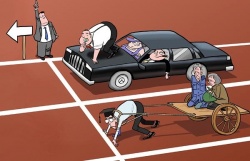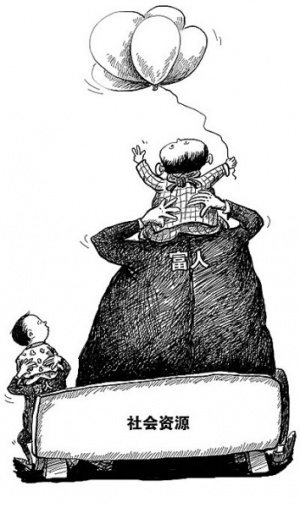“Poor second generation”的版本间的差异
来自China Digital Space
| 第1行: | 第1行: | ||
贫二代 (pín èr dài): poor second generation | 贫二代 (pín èr dài): poor second generation | ||
| + | [[File:poor.jpg|250px|thumb|right|''For the poor second generation, parents are more of a burden than an asset. For the [[rich second generation]], the opposite is true.]] | ||
| + | |||
| + | [[File:poor2.jpg|300px|thumb|right|''The larger figure, labeled “rich person,” holds his child aloft next to the smaller “poor person.” Both figures sit on a bench labeled “Society's Resources.”]] | ||
Before China’s reform and opening up, Communism had substantially leveled the playing field and most people were more or less on the same economic level. With [http://en.wikipedia.org/wiki/Chinese_economic_reform Deng Xiaoping's free market reforms], the gap between rich and poor became more apparent and began to widen. The children of those who prospered during the reform and opening up period are call the “[[rich second generation]],” while the children of those who did not prosper are called the “poor second generation.” Commentators complain that institutional barriers (high cost of education, importance of connections, etc.) serve as barriers standing between the poor second generation and economic mobility. | Before China’s reform and opening up, Communism had substantially leveled the playing field and most people were more or less on the same economic level. With [http://en.wikipedia.org/wiki/Chinese_economic_reform Deng Xiaoping's free market reforms], the gap between rich and poor became more apparent and began to widen. The children of those who prospered during the reform and opening up period are call the “[[rich second generation]],” while the children of those who did not prosper are called the “poor second generation.” Commentators complain that institutional barriers (high cost of education, importance of connections, etc.) serve as barriers standing between the poor second generation and economic mobility. | ||
| 第5行: | 第8行: | ||
See also [[governing second generation]], [[rich second generation]], and China Digital Times' news coverage of the [http://chinadigitaltimes.net/china-news/focus/the-great-divide/ gap between rich and poor]. | See also [[governing second generation]], [[rich second generation]], and China Digital Times' news coverage of the [http://chinadigitaltimes.net/china-news/focus/the-great-divide/ gap between rich and poor]. | ||
| − | |||
| − | |||
| − | |||
[[Category: Grass-Mud Horse Lexicon]] | [[Category: Grass-Mud Horse Lexicon]] | ||
2013年10月7日 (一) 18:29的版本
贫二代 (pín èr dài): poor second generation

Before China’s reform and opening up, Communism had substantially leveled the playing field and most people were more or less on the same economic level. With Deng Xiaoping's free market reforms, the gap between rich and poor became more apparent and began to widen. The children of those who prospered during the reform and opening up period are call the “rich second generation,” while the children of those who did not prosper are called the “poor second generation.” Commentators complain that institutional barriers (high cost of education, importance of connections, etc.) serve as barriers standing between the poor second generation and economic mobility.
See also governing second generation, rich second generation, and China Digital Times' news coverage of the gap between rich and poor.





